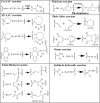Click Chemistry-Based Injectable Hydrogels and Bioprinting Inks for Tissue Engineering Applications
- PMID: 30603577
- PMCID: PMC6171698
- DOI: 10.1007/s13770-018-0152-8
Click Chemistry-Based Injectable Hydrogels and Bioprinting Inks for Tissue Engineering Applications
Abstract
Background: The tissue engineering and regenerative medicine approach require biomaterials which are biocompatible, easily reproducible in less time, biodegradable and should be able to generate complex three-dimensional (3D) structures to mimic the native tissue structures. Click chemistry offers the much-needed multifunctional hydrogel materials which are interesting biomaterials for the tissue engineering and bioprinting inks applications owing to their excellent ability to form hydrogels with printability instantly and to retain the live cells in their 3D network without losing the mechanical integrity even under swollen state.
Methods: In this review, we present the recent developments of in situ hydrogel in the field of click chemistry reported for the tissue engineering and 3D bioinks applications, by mainly covering the diverse types of click chemistry methods such as Diels-Alder reaction, strain-promoted azide-alkyne cycloaddition reactions, thiol-ene reactions, oxime reactions and other interrelated reactions, excluding enzyme-based reactions.
Results: The click chemistry-based hydrogels are formed spontaneously on mixing of reactive compounds and can encapsulate live cells with high viability for a long time. The recent works reported by combining the advantages of click chemistry and 3D bioprinting technology have shown to produce 3D tissue constructs with high resolution using biocompatible hydrogels as bioinks and in situ injectable forms.
Conclusion: Interestingly, the emergence of click chemistry reactions in bioink synthesis for 3D bioprinting have shown the massive potential of these reaction methods in creating 3D tissue constructs. However, the limitations and challenges involved in the click chemistry reactions should be analyzed and bettered to be applied to tissue engineering and 3D bioinks. The future scope of these materials is promising, including their applications in in situ 3D bioprinting for tissue or organ regeneration.
Keywords: 3D bioprinting; Click chemistry; Hydrogels; Regenerative medicine; Tissue engineering.
Conflict of interest statement
The authors declare that they have no conflict of interest.There are no animal or human experiments carried out for this article.
Figures





Similar articles
-
Alginate modification via click chemistry for biomedical applications.Carbohydr Polym. 2021 Oct 15;270:118360. doi: 10.1016/j.carbpol.2021.118360. Epub 2021 Jun 19. Carbohydr Polym. 2021. PMID: 34364605 Review.
-
Click Chemistry Hydrogels for Extrusion Bioprinting: Progress, Challenges, and Opportunities.Biomacromolecules. 2022 Mar 14;23(3):619-640. doi: 10.1021/acs.biomac.1c01105. Epub 2022 Jan 6. Biomacromolecules. 2022. PMID: 34989569 Review.
-
Advancing bioinks for 3D bioprinting using reactive fillers: A review.Acta Biomater. 2020 Sep 1;113:1-22. doi: 10.1016/j.actbio.2020.06.040. Epub 2020 Jul 2. Acta Biomater. 2020. PMID: 32622053 Review.
-
Employing PEG crosslinkers to optimize cell viability in gel phase bioinks and tailor post printing mechanical properties.Acta Biomater. 2019 Nov;99:121-132. doi: 10.1016/j.actbio.2019.09.007. Epub 2019 Sep 17. Acta Biomater. 2019. PMID: 31539655
-
Click chemistry-based biopolymeric hydrogels for regenerative medicine.Biomed Mater. 2021 Mar 16;16(2):022003. doi: 10.1088/1748-605X/abc0b3. Biomed Mater. 2021. PMID: 33049725
Cited by
-
Fabrication Strategies Towards Hydrogels for Biomedical Application: Chemical and Mechanical Insights.Chem Asian J. 2022 Nov 16;17(22):e202200797. doi: 10.1002/asia.202200797. Epub 2022 Oct 5. Chem Asian J. 2022. PMID: 36112345 Free PMC article. Review.
-
Rapid synthesis of functional poly(ester amide)s through thiol-ene chemistry.RSC Adv. 2023 Jul 28;13(33):22928-22935. doi: 10.1039/d3ra03478j. eCollection 2023 Jul 26. RSC Adv. 2023. PMID: 37520100 Free PMC article.
-
Photo-Polymerization Damage Protection by Hydrogen Sulfide Donors for 3D-Cell Culture Systems Optimization.Int J Mol Sci. 2021 Jun 5;22(11):6095. doi: 10.3390/ijms22116095. Int J Mol Sci. 2021. PMID: 34198821 Free PMC article.
-
Injectable hydrogels for bone and cartilage tissue engineering: a review.Prog Biomater. 2022 Jun;11(2):113-135. doi: 10.1007/s40204-022-00185-8. Epub 2022 Apr 14. Prog Biomater. 2022. PMID: 35420394 Free PMC article. Review.
-
3D printable hyaluronic acid-based hydrogel for its potential application as a bioink in tissue engineering.Biomater Res. 2019 Feb 6;23:3. doi: 10.1186/s40824-018-0152-8. eCollection 2019. Biomater Res. 2019. PMID: 30774971 Free PMC article.
References
-
- Zou Y, Zhang L, Yang L, Zhu F, Ding M, Lin F, et al. “Click” chemistry in polymeric scaffolds: bioactive materials for tissue engineering. J Control Release. 2018;273:160–179. - PubMed
-
- Xu Z, Bratlie KM. Click chemistry and material selection for in situ fabrication of hydrogels in tissue engineering applications. ACS Biomater Sci Eng. 2018;4:2276–2291. - PubMed
-
- Kolb HC, Finn MG, Sharpless KB. Click chemistry: diverse chemical function from a few good reactions. Angew Chem Int Ed Engl. 2001;40:2004–2021. - PubMed
-
- Jiang Y, Chen J, Deng C, Suuronen EJ, Zhong Z. Click hydrogels, microgels and nanogels: emerging platforms for drug delivery and tissue engineering. Biomaterials. 2014;35:4969–4985. - PubMed
Publication types
LinkOut - more resources
Full Text Sources
Other Literature Sources
